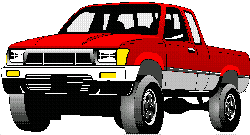Pickup trucks
How popular are they? Well, consumers buy about 3 million new pickups each year. That's one out of every five new vehicles sold in the U.S. Pickups are built for work, and their construction reflects that. Unlike passenger cars which employ "unibody" construction, pickups are built on heavy steel frame rails, with stronger stronger suspensions as well. There's extra ground clearance for driving off-road and over rough terrain. Many pickups offer heavy-duty engines and transmissions, for hauling heavy loads and towing, or other features to suit user needs. New models also provide more safety features, such as as dual air bags, improved side-impact protection and anti-lock brakes. Compact pickups: This vehicle concept -- smaller, lighter versions of the standard pickup truck -- became popular in the late 1970's and early 1980's. While consumer demand for very small pickups has slowed in recent years, compact pickups continue to attract about 1 million buyers each year. Most compact pickups have 4-cylinder engines (some with optional 6-cylinder) and moderate-sized cargo beds. Many now offer extended cabs, with small rear seats for children or cargo. While compact pickups lack the hauling power of full-sized pickups, they are usually priced less and provide higher fuel economy levels. For motorists who haul loads of moderate size and weight, a compact pickup may be just right.
Full-size pickups: These "traditional" pickups are built for larger or heavier cargo loads, and continue to serve those important transport needs. All come with 6- or 8-cylinder engines, heavy-duty transmissions, strong suspension, and large cargo beds. Many also offer optional extended cabs (for extra passengers), additional doors (for access to extended cabs) and extended beds (for long loads). Standard pickups remain big sellers, about 2 million a year, in a competitive market. They are frequently purchased for commercial uses, including farming, ranching, construction, landscaping, and are really "tools of the trade" for those businesses. While their gas mileage ratings are lower than compact pickups, these vehicles are quite efficient for the work they do Full-size pickups come in different configurations, varying primarily in hauling capability. Pickups are often classified by users and manufacturers as "½-ton," "¾-ton," or "1-ton," referring to how much cargo the vehicle can safely haul. The government frequently uses a different system: "gross vehicle weight rating" (GVWR), the combined weight of the truck, passengers and cargo.
Federal standards: Here's what the government requires on pickups and other light trucks:
|
 THEY'RE AMONG THE BEST-SELLING and most
versatile vehicles in the U.S., used on farms and construction sites to
haul goods of all shapes and sizes, to transport people in rural areas,
and many other tasks. Pickup trucks are truly the work-horses of 20th
century America -- not plush, but sturdy, dependable, and efficient for
their intended uses.
THEY'RE AMONG THE BEST-SELLING and most
versatile vehicles in the U.S., used on farms and construction sites to
haul goods of all shapes and sizes, to transport people in rural areas,
and many other tasks. Pickup trucks are truly the work-horses of 20th
century America -- not plush, but sturdy, dependable, and efficient for
their intended uses.